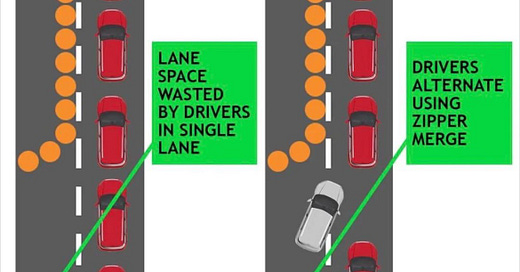Born in New York, now living in Virginia, I noticed that drivers are too nice. Yes, you can be too nice. The price is accidentally costing time for every other driver on the road. Nothing captures the unintended consequence of overly kind driving more than the failure to use the Zipper Merge.
Best illustrated with this image:
What are you doing in this road situation?
Are you the guy/gal inching your car into the center lane, blocking anybody from switching lanes?
If so, guess what? You are the asshole. You are doing it wrong.
Zipper Merging is an example of a “collective action problem” where people care more about themselves and act egocentrically. When everyone acts the same way without concern for the cumulative impact on people around them, a problem arises that a lone person) cannot resolve.
Hatred of the Zipper Merge is one problem with an individualism mindset, which is the norm in individualistic societies. Consider this a public service announcement for stealing functional elements from collectivism.
Exemplary Collectivism Actions
Scandinavian Social Democracy: Scandinavian countries balance individual freedoms with shared responsibilities. They illustrate how collectivism can work, offering universal healthcare and affordable higher education for all citizens.
Worker Cooperatives: These workplaces operate on a collectivist principle with all workers owning the business. This ownership creates a flat hierarchy and a vested interest in the group's success, encouraging collaboration over competition.
Military Organizations: Soldiers operate in highly coordinated units where reliance on each other is crucial. The collective mindset, vital in life-or-death situations, fosters deep trust and unity, highlighting the importance of putting the group's safety above individual concerns.
Reversal
This Zipper Merge strategy works best when the average speed of cars is less than 15 mph. As soon as the average speed is closer to 30 mph, this becomes messy as drivers face uncertainty about unpredictable driver behavior. This leads to rapid breaking which has a cascading effect on other drivers, producing unnecessary traffic jams.
Conclusion
You might be hesitant to deviate from the norm, but by following the herd you + me + everyone else on the road is spending time inefficiently. The days are short, use them better - Zipper Merge.
Thanks for reading Provoked. If you’d like to support my work please:
Leave a comment (I respond to each of them) - and for this post, anyone can comment.
Leave a ❤️ so that others can find it.
Share this post by email or on social media.
Start a paid subscription to this Substack (with lots of benefits).
Todd B. Kashdan is an author of several books including The Upside of Your Dark Side (Penguin) and The Art of Insubordination: How to Dissent and Defy Effectively (Avery/Penguin) and Professor of Psychology and Leader of The Well-Being Laboratory at George Mason University.
Read Past Issues Here Including:
A Cheat Sheet for Fixing Broken Systems - Politics, Education, Law, Work, Relationships
Every day in America seems like the perfect time to discuss principled dissent. Just yesterday, some guy tracked a middle-aged woman down (who probably makes minimum wage) as a Home Depot cashier. Her offense? She wrote something malicious about Donald Trump on Facebook (“





Don’t you think this is an oversimplification? Just yesterday, I was one of the cars in the right lane, and a car in the left lane attempted to merge into the right lane and rear-ended me.
Why does the merge have to happen at that last moment? I'm sure there is a mathematical reason, but in reality most cars move to the right a little 'early' which leads to a few other cars, that I can only presume have an elevated sense of their own importance, zooming up the left like they've discovered a private highway, to then push their way in at the last moment...oh wait, they execute a zipper merge.